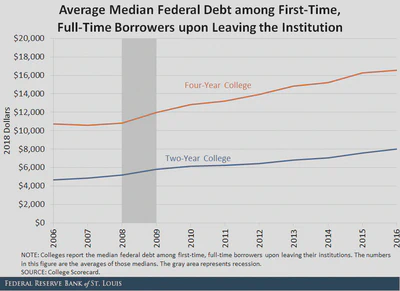HW07: Machine learning
Overview
Due by 11:59pm CT (Chicago) on July 11th.
Accessing the hw07 repository
Go here and find your copy of the hw07 repository. It follows the naming convention hw07-<USERNAME>. Clone the repository to your computer.
Part 1: Student debt
Median student debt in the United States has increased substantially over the past twenty years.

rcis::scorecard includes debt, which reports the median debt of students after leaving school in 2019.
unitid and name as predictors. These serve as id variables in the data set and uniquely identify each observation. They are not useful in predicting an outcome of interest.- Split
scorecardinto training and test sets with 75% allocated to training and 25% allocated to testing. - Estimate a basic linear regression model to predict
debtas a function of all the other variables in the dataset except forstate. Report the RMSE for the model.1 - Estimate the same linear regression model, but this time implement 10-fold cross-validation. Report the RMSE for the model.
- Estimate a decision tree model to predict
debtusing 10-fold cross-validation. Use therpartengine. Report the RMSE for the model.
For those looking to stretch themselves
Estimate one or more models which utilize some aspect of feature engineering or model tuning. Discuss the process you used to estimate the model and report on its performance.
Part 2: Predicting attitudes towards racist college professors
The General Social Survey is a biannual survey of the American public.2
rcis::gss contains a selection of variables from the 2012 GSS. You are going to predict attitudes towards racist college professors. Specifically, each respondent was asked “Should a person who believes that Blacks are genetically inferior be allowed to teach in a college or university?” Given the kerfuffle over Richard J. Herrnstein and Charles Murray’s The Bell Curve and the ostracization of Nobel Prize laureate James Watson over his controversial views on race and intelligence, this analysis will provide further insight into the public debate over this issue.
The outcome of interest colrac is a factor variable coded as either "ALLOWED" (respondent believes the person should be allowed to teach) or "NOT ALLOWED" (respondent believes the person should not allowed to teach).
Use the gss data frame, not gss_colrac. To ensure you have the correct data frame loaded, you can run:
data("gss", package = "rcis")
id and wtss as predictors. These serve as id variables in the data set and uniquely identify each observation. They are not useful in predicting an outcome of interest.Split
gssinto training and test sets with 75% allocated to training and 25% allocated to testing.Estimate a logistic regression model to predict
colracas a function ofage,black,degree,partyid_3,sex,andsouth. Implement 10-fold cross-validation. Report the accuracy of the model.Estimate a random forest model to predict
colracas a function of all the other variables in the dataset (exceptidandwtss). In order to do this, you need to impute missing values for all the predictor columns. This means replacing missing values (NA) with plausible values given what we know about the other observations.- Remove rows with an
NAforcolrac- we want to omit observations with missing values for outcomes, not impute them - Use median imputation for numeric predictors
- Use modal imputation for nominal predictors
Implement 10-fold cross-validation. Report the accuracy of the model.
- Remove rows with an
Estimate a $5$-nearest neighbors model to predict
colrac. Userecipesto prepare the data set for training this model (e.g. scaling and normalizing variables, ensuring all predictors are numeric). Be sure to also perform the same preprocessing as for the random forest model. Make sure your step order is correct for the recipe. Implement 10-fold cross-validation. Report the accuracy of the model.Estimate a ridge logistic regression model to predict
colrac.3 Use the same recipe as for the $5$-nearest neighbors model. Implement 10-fold cross-validation, and utilize the same recipe as for the $k$-nearest neighbors model. Report the accuracy of the model.Select the best performing model. Train that recipe/model using the full training set and report the accuracy using the held-out test set of data.
For those looking to stretch themselves
Estimate some set of additional models which utilize some aspect of feature engineering or model tuning. Discuss the process you used to estimate the model and report on its performance.
?gss to open a documentation file in R.Submit the assignment
Your assignment should be submitted as a set of two R Markdown documents using the github_document format. Follow instructions on homework workflow.
Rubric
Needs improvement: Cannot get code to run or is poorly documented. No documentation in the README file. Severe misinterpretations of the results. Overall a shoddy or incomplete assignment.
Satisfactory: Solid effort. Hits all the elements. No clear mistakes. Easy to follow (both the code and the output). Nothing spectacular, either bad or good.
Excellent: Interpretation is clear and in-depth. Accurately interprets the results, with appropriate caveats for what the technique can and cannot do. Code is reproducible. Writes a user-friendly README file. Implements appropriate visualization techniques for the statistical model. Results are presented in a clear and intuitive manner.
View the documentation for
yardstickto find the appropriate function for RMSE. ↩︎Conducted by NORC at the University of Chicago. ↩︎
logistic_reg(penalty = .01, mixture = 0)↩︎